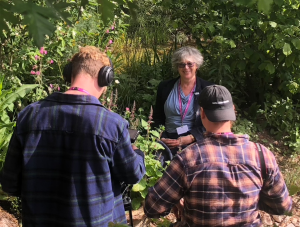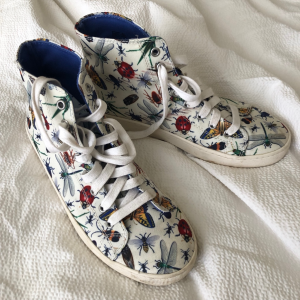Dr Tilly Collins is a senior academic at the Centre for Environmental Policy. Her interdisciplinary research focuses on enhancing the environmental, social and economic sustainability in land-use transitions. She has a passion for entomology and makes regular media appearances to advocate for the crucial role of insects in future sustainability.
I am unashamedly and unabashedly an entomologist. I came to this realisation a bit late and only really fell in love with the insect world while doing my PhD at the Imperial College campus at Silwood Park as a decade-delayed mature student. My field work there was spent estimating insect numbers (especially of aphids) in willow plantations and listening to the hum and thrum of the array of life around me.
This was the start of my lifelong passion for working with insects, and spreading what I know to others so that, together, we can build an insect-positive future.

Overcoming the societal entomophobia
At first, I was twitchy when unfamiliar critters landed on my skin or got caught in my hair, but over those three summers of research guided by the ‘EntoProf’ Professor Simon Leather, I grew confident, learnt to look more carefully, understood the roles of insects and felt at peace with the vibrancy of the entomological world.
Insects are wonderful, marvellous, diverse and essential to the functioning of our natural world and, yet, most people are either repelled or very, very cautious. Some of this fear and repulsion is just brought about by unfamiliarity, especially to those who live in cities and see only a small subset of the great diversity of insect life.
This subset is often made up of the rapid dispersers and rapid breeders, many of which we consider as pests: the ants in the kitchen, the cockroaches around the bins, the nits in our children’s hair and the (much-misunderstood) wasps feeding from our picnics.
The fear of insects is also culturally learned and reinforced by language commonly used to refer to insects: ‘creepy’, ‘pest’, ‘scary’, ‘stingy’, ‘itchy’. Some of the fear, though, is also innate and embedded in our evolutionarily adaptive responses to potential threats. When we lived in caves and early houses, small scuttling, fast moving things seen out of the corner of our eye might be dangerous and unexpected things also often just make us jump.

Luckily for us here in the UK, few insect species are really dangerous, though a few can trigger allergies or, like some female mosquitoes, can feed on us. Here, the vast majority of insect species are beneficial. They either contribute directly by helping to, for example, create and improve our soil or pollinate our crops.
Their utility can also be indirect. As predator species, they help keep other insect species in check (wasps are brilliant at that), by providing food for other animals and even carnivorous plants, and by ensuring the natural world can deliver the ecosystem services on which our lives depend.
Learning to love insects
To combat the various fears and help people to view insects through another lens, I do ‘insecty outreach’. Over several decades, this has taken many forms. I’ve worked with primary schools to develop a ‘bug club’ syllabus that inexperienced teachers of entomology can use. I’ve been on the stage at the excellent ’Pint of Science’ events extolling the virtues of some insects as sustainable foodstuffs. I have even helped the (very excellent) Royal Entomological Society by being an interpreter at the ‘insect-positive’ RHS Chelsea Garden.
The 2019, 2022 and 2023 Great Exhibition Road Festivals have each been wonderful vehicles for communicating the concept of insects as food and feed (mainly for chickens and fish), so we can see them as part of a sustainable and circular system. We can use insects to transform our agricultural and food production wastes into nutritionally very complete proteins and use their by-products as soil conditioners, but it takes some getting used to!
Anywhere I go, I will bring up insects – everything from an, “Oh, look, a magnificent ground beetle, a fearsome predator the insect world,” to, “Have you tasted my cricket brownies?”

It is only recently that the idea as insects as positive forces has come to the wider public consciousness. This is mainly associated with movements like ‘Save the Bees’ and an awareness that pollination as an insect-provided ecosystem service is really quite important. (About three-quarters of the crops we grow are dependent on insect pollination to some extent.)
This positive lens, tied to a growing awareness that our decimation of the natural world is reaching a critical phase, has helped enormously. Already, there is less resistance and more curiosity coming into the conversations I have.
Spreading accurate information with humour and humility is an excellent part of my job and seeing a person’s face shift from skepticism to curiousity and optimism is one of the most rewarding parts of bringing entomology to the public.
The growing awareness and advocacy of the past few years have been transforming knowledge of, and attitude to, insects and their place in the natural world. I hope that all the work that I do in this sphere will help shift the balance towards insect-positive futures and that this may help heal the nature-based services that ecosystems provide.
The many of us who help with insecty outreach wish that a greater communication of our scientific understanding will help us to restore the natural world.